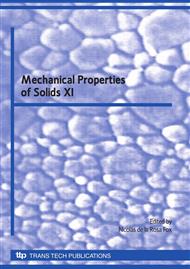p.113
p.119
p.125
p.131
p.137
p.147
p.155
p.161
p.167
A Study of the Mechanical Properties and Recrystallization of Two Types of Foil of Aluminium 1050 A
Abstract:
An experimental study of the variation of the mechanical properties of sheets of aluminium alloy 1050A due to heat treatment has been carried out. For this purpose, sheets and foils rolled from continuous casting strip (CCS) and from hot rolling strip (HRS) have been prepared in the laboratory. Initially, CCS and HRS had a thickness of 7,5 mm and 3,0 mm respectively. The final thickness achieved in both cases was 0,20 mm. In order to obtain hardening curves for CCS and HRS sheets and foils, specimens of different thickness were taken during the rolling process. Oven treatments were carried out for drawing softening curves of foils. Foil proceeding from CCS presents hardening due to the precipitation of Al3Fe particles at a temperature range of 160°C to 220 °C. HRS foil has a lower hardening in the same range of temperatures owing to its low supersaturation of Fe. Correlation between ultimate tensile strength Rm and Vickers hardness is studied. Micrographies of optical microscopy are offered at hard and recrystallized conditions.
Info:
Periodical:
Pages:
137-145
Citation:
Online since:
December 2009
Price:
Сopyright:
© 2010 Trans Tech Publications Ltd. All Rights Reserved
Share:
Citation:


